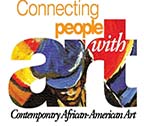Shaper of God, an exhibition by American Artist at Brooklyn’s Pioneer Works art centre, is the culmination of a four-year project inspired by the life and work of Octavia E. Butler. The show’s title is taken from a religious text written by Lauren Oya Olamina, the protagonist of Butler’s 1993 novel Parable of the Sower
Photo: Dan Bradica; Courtesy of American Artist and Pioneer Works
Octavia E. Butler’s writing has never been more relevant. The Pasadena native and MacArthur “genius” award-winning speculative-fiction author foresaw the world we live in today in her books Parable of the Sower (1993) and Parable of the Talents (1998).
Set in the 2020s and 30s, these novels depict an America where the social fabric of society has been torn to shreds because of unchecked climate change, an unbridgeable divide between rich and poor, and the election of increasingly authoritarian presidents, including one who promises to “make America great again”. When asked by a student during a book signing if she really thought the future would be as grim as she imagined it, Butler recalled telling him: “I didn’t make up the problems… All I did was look around at the problems we’re neglecting now and give them about 30 years to grow into full-fledged disasters.”
This incisive perception is what makes Butler such an enduring influence, not just for readers, but for fellow creatives, including contemporary visual artists. “What’s so amazing about her as a sci-fi writer, and the thing that I love so much about sci-fi, is that it’s a literary discipline in which you speculate about what’s possible based on what can be known,” the artist Cauleen Smith tells The Art Newspaper. Smith has been an avid reader of Butler’s work for decades and created a short film based on the author’s 1979 classic, Kindred—in which a modern-day Black woman from California is spontaneously transported to a plantation in 19th-century Maryland. “Octavia Butler played with that and pushed those rules as much as she could,” Smith says. “All she did was observe and report through a speculative lens. That’s the true genius of this woman.”
A student of human nature
John Jennings, an illustrator, author and professor at the University of California, Riverside, worked on the adaptation of Butler’s Kindred and Parable of the Sower into award-winning graphic novels. He says her basis in reality is what makes people return to Butler’s work over the years. “It isn’t about her being a soothsayer or her being magical… She’s just an extremely talented researcher and writer, and she is a student of human nature,” he says. “She wrote these [books] as a parable to warn us about what could happen if these things continued.” In Parable of the Talents, which is also being adapted into a graphic novel (to be released in April), shock collars are used to enslave the incarcerated and unhoused; mobs of Christian fundamentalists rape and kill those who do not share their beliefs; and children are separated from their families and placed in abusive adoptive homes.
Butler’s “willingness to confront difficult questions about power, hierarchy and humanity’s capacity for both destruction and resilience is what has made her an enduring influence, especially in times of crisis”, says the artist Zainab Aliyu, who edited the catalogue for American Artist’s Shaper of God exhibition at Pioneer Works in Brooklyn (until 13 April)—a show inspired by Butler’s writing and their shared personal histories. “People often read her work and marvel at its prescience, but it’s not enough to just acknowledge these alignments,” Aliyu says. “Her work asks us to confront the cycles of oppression and resilience that define our histories and futures, and to actively shape those futures for the better.”
The artist Connie Samaras met Butler a few times in the 1990s while working on a project to correct the representations of Earth culture that had been sent aboard the 1977 Voyager space probes, making them less Eurocentric and patriarchal. “I was utterly intimidated by her,” Samaras says. “She was an exceptional human being and incredibly brave. She took in everything around her and built [new] worlds but understood it was always a contested terrain, and that change is a constant.”
What Samaras finds so compelling in Butler’s novels is the push for intersectional co-operation, with characters from varying backgrounds and ethnicities banding together to survive and rebuild. “She was prescient in understanding that the answer was going to be a kind of collectivity,” Samaras says.
Octavia E. Butler with her last book, Fledgling. The writer died in 2006, before many of her prescient predictions were to come true.
Malcolm Ali/Wireimage
Complexity made straightforward
It is not just the accuracy of Butler’s books that continues to draw people in. “The thing that I love about Octavia’s writing is it is straight, no chaser, but the writing is smooth like a really good whisky,” says Tamisha Tyler, a poet and theologian who is researching Butler’s archive for a book focusing on Earthseed, the religion at the centre of the Parables books. This directness makes Butler’s writing hit all the harder, Tyler says, “because she’s talking about very complex things in a straightforward way”. In many of Butler’s books, survival is a complicated goal that often forces characters to make difficult or unconscionable decisions.
It is this complexity that has made Butler’s archive—now housed at the Huntington Library, Art Museum and Botanical Gardens in Pasadena—such a rich resource for artists and scholars. “It is the single most requested [collection] to this day,” says Karla Nielsen, the Huntington’s senior curator of literary collections, “and we are an institution that has really incredible holdings, including 17th- and 18th-century British and early American historical documents. So [the fact] that the Butler archive receives more requests than any one of those collections is really remarkable.”
When the archive—numbering some 398 boxes containing more than 8,000 items—first came to the Huntington soon after Butler’s untimely death in 2006 at the age of 58, cataloguing the contents and making them available to researchers became a priority, Nielsen says. This was, in part, because of the understanding that Butler’s reputation was on the rise. “This was someone whose importance was not fading but crescendoing and increasing,” Nielsen says.
Cauleen Smith’s 2015 drawing of Butler’s book Wild Seed, published in 1980
‘Octavia tried to tell us’
This has proven to be true, with the phrase “Octavia tried to tell us” becoming a regular refrain online in recent years, and more and more readers returning to her books—perhaps to prepare for what might be coming next. It has also raised the question of what Butler, who died before the iPhone hit the market and Elon Musk’s first SpaceX rockets managed to reach orbit, would say about the world today.
“Like so many people of her generation, I think there [would be] a real sadness about our inability to have prevented this—or a refusal to have prevented it,” Cauleen Smith says. “And also, there would be more books that people wouldn’t even be ready for.”
Tamisha Tyler thinks, first and foremost, that Butler would carry “a prophet’s grief. Her intent was never to write something to come true. It was to write something so that we can see the possibility of change and do something differently.” Butler might also be annoyed with those who looked to her to provide answers to society’s problems, as well as hopeful about the people working to evoke change. Tyler imagines her saying: “Look to the artists, look to the caretakers, look to the people already doing the work.”
The book, which was published 30 years ago, is inspiring performances and installations across the US
The late author’s sci-fi stories have inspired artists such as Alberta Whittle, Candice Breitz, Toyin Ojih Odutola and Precious Okoyomon
In their new show at Pioneer Works in New York, American Artist reflects on Butler’s most famous series of novels and her archives

